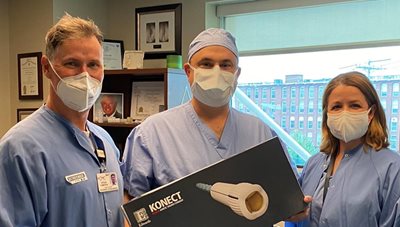As published in the NH Union Leader
KONECT makes a difficult procedure safer and faster.
Repairing an aortic aneurysm is never a simple thing, but thanks to a new device now in use at Catholic Medical Center, one particular procedure just got a little easier.
 “It’s safer and faster for the patient as well,” said Dr. David Caparrelli, FACS, a cardiothoracic surgeon at CMC’s New England Heart & Vascular Institute, of the KONECT RESILIA Aortic Valved Conduit. That long name describes a significant advancement in the gold-standard approach for treating complicated aneurysms in the ascending aorta.
“It’s safer and faster for the patient as well,” said Dr. David Caparrelli, FACS, a cardiothoracic surgeon at CMC’s New England Heart & Vascular Institute, of the KONECT RESILIA Aortic Valved Conduit. That long name describes a significant advancement in the gold-standard approach for treating complicated aneurysms in the ascending aorta.
The aorta is the main artery that carries blood away from the heart. The ascending aorta is the portion of that artery closest to the heart.
“There’s a lot of important stuff right there, including the aortic root, which is the part that connects to the heart and contains the aortic valve,” notes Dr. Caparrelli.
An aneurysm—or a thinning and bulging of the artery wall—of the ascending aorta or the aortic root is particularly dangerous and complex to treat.
“There is no minimally invasive approach to this part of the body,” said Caparrelli. An aneurysm like this is less common than other types of aneurysms and harder to diagnose. There usually aren’t any clear symptoms, but it can cause fatal bleeding if it’s not detected and the aorta tears or ruptures.
“An aneurysm of the ascending aorta and aortic root is most often detected when a patient has an echocardiogram or a chest x-ray for another reason, like lung cancer. It’s much better to treat it in an elective situation than if the patient comes in with a tear or rupture, which is an emergency,” Caparrelli said.
Treatment for this kind of aneurysm includes monitoring by the medical team at the New England Heart & Vascular Institute’s Aortic Clinic. When the aneurysm becomes large—about five centimeters in most cases— surgery is warranted to place a graft in the aorta and replace the aortic valve.
“In a typical surgery,” explains Dr. Caparrelli, “the surgeon uses a prosthetic graft to replace the aorta. Doing this so close to the heart necessitates replacing the aortic valve as well. In the past, the surgeon would have to sew the new valve to the graft in the operating room or be forced to use a mechanical valve, which would mean the patient would be on lifelong blood thinners.”
But the KONECT, made by Edwards Lifesciences, takes that work out of the equation with the graft and valve preassembled and ready to implant. “We’re getting the very best graft and the very best tissue valve in one device. This saves time and patients don’t need blood thinners,” said Caparrelli.
The advancement shortens the procedure, which can mean life-saving minutes in an emergency surgery. Edwards also suggests that the valve used in the KONECT is made in a way that improves durability and can promote quality of life for patients after surgery.
Caparrelli used the KONECT for the first time earlier this month, making CMC the first hospital in New Hampshire to adopt the technology since its FDA approval in July. “We’ve been waiting for this for a long time,” Caparrelli said. “(Surgeons) really like the valve and we really like the graft and we’ve been using both separately. Having both together is a real advance.”
in the photo (left to right): Stephen Cameron of Edwards Lifesciences, Dr. David Caparrelli and Rebecca Natale, also from Edwards, after the first KONECT procedure was performed in NH at CMC